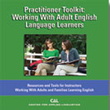Promoting education and achievement of adults learning English
Digests
Education for Adult English Language Learners in the United States: Trends, Research, and Promising Practices
Carol Van Duzer and MaryAnn Cunningham Florez
National Center for ESL Literacy Education
December 1999
This paper, written by staff of the Center for Applied Linguistics, describes the adult education system in the United States — learner populations, programs serving them, assessment, professional development for practitioners, and research.
This paper describes education for adult English language learners in the United States, focusing on the following topics:
- Characteristics of the foreign-born population
- Foreign-born adults enrolled in adult ESL programs, their access to and participation in programs, and factors that affect their participation and success
- The types of instructional programs that serve adult English language learners
- Professional development for teachers of this population
- The U.S. adult education assessment and accountability system
- Future directions in English literacy education and lifelong learning
Acknowledgements
This paper has benefited from the perspectives of a number of knowledgeable practitioners and researchers. It is through their comments and suggestions that we were able to bring together the many relevant aspects of the delivery of instruction for adults learning English in the United States.
The staff of the Center for Adult English Language Acquisition (CAELA) Network project at CAL developed the paper. Kirsten Schaetzel and Sarah Young served as primary authors, pulling together the major research and promising practices in the field. Miriam Burt and Joy Kreeft Peyton helped to define and shape the paper, and Sharon McKay and Lynda Terrill provided valuable content expertise. Lynda Terrill designed the document for publication on the web.
JoAnn Crandall, University of Maryland Baltimore County, and Heide Spruck Wrigley, Literacywork International, provided substantive and valuable comments on a draft of the paper.
Staff of the United States Department of Education, Office of Vocational and Adult Education, including Christopher Coro, Lynn Spencer, and Tanya Shuy, offered their insights and comments on a variety of aspects of the paper.
Download the PDF ![]() (2.27MB)
(2.27MB)
II. The Foreign-Born Population in the United States
III. Participation of Foreign-Born Adults in Adult Education Programs
IV. Program Design and Instructional Practice
V. Professional Development and Teacher Quality
VI. Assessment and Accountability
VII. Future Directions for Lifelong Learning
Appendix: NRS ESL Educational Functioning Levels ![]() (94.4KB)
(94.4KB)
Center for Adult English Language Acquisition (CAELA) Network
Center for Applied Linguistics, Washington, DC, April 2010
The Education for Adult English Language Learners in the United States: Trends, Research, and Promising Practiceswas developed by CAELA Network staff in cooperation with the Office of Vocational and Adult Education (OVAE), U.S. Department of Education. Visit the OVAE Web site.
This document was produced at the Center for Applied Linguistics (4646 40th Street, NW, Washington, DC 20016 202-362-0700) with funding from the U.S. Department of Education (ED), Office of Vocational and Adult Education (OVAE), under Contract No. ED-07-CO-0084. The opinions expressed in this report do not necessarily reflect the positions or policies of ED. This document is in the public domain and may be reproduced without permission.

